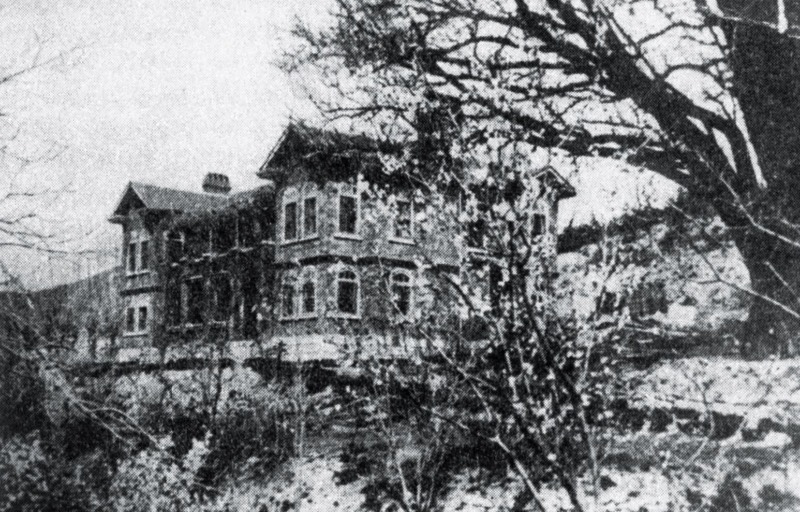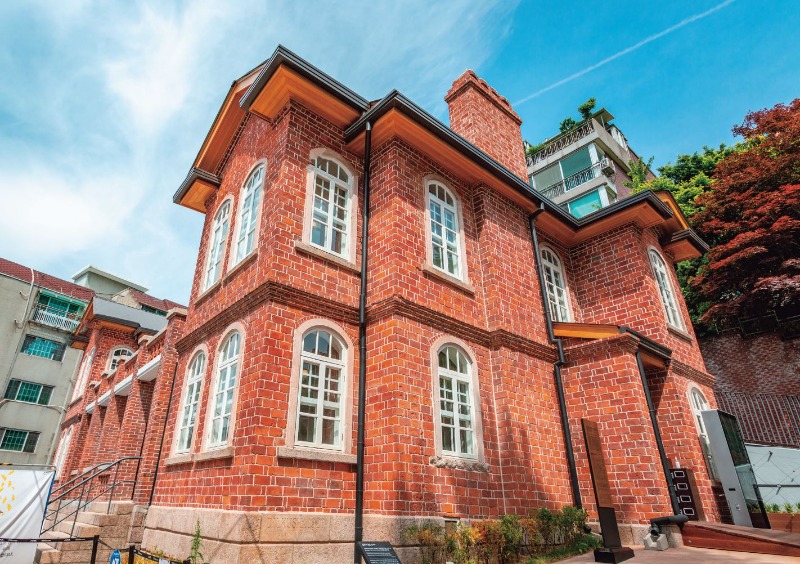The most recognizable Western-style home in Seoul during the 1920s fell into the dustbin ofhistory, literally and figuratively. Decades later, the role of its occupants and their life storyinspired a government-led restoration, turning the worn-down building into an attractive house museum.

Dilkusha, a Western-style red-brick house in Haengchon-dong, Seoul, was built in 1923 byAmerican businessman and news correspondent Albert Taylor and his wife, British actress MaryLinley Taylor. An old photograph of the house appeared in “Village Outside Donuimun, Below theFortress Wall: History, Space, Housing,” published in 2009 by the Seoul Metropolitan Government.

Dilkusha exemplifies the construction techniques of Western-style houses built in Korea in the early 20th century. The outer wall was built by laying bricks on the side with alternating layers of headers and stretchers.
Albert Taylor arrived in Korea in the late 1890s, when his father started a gold mining project in North Pyongan Province. Taylor and his British actress wife, Mary Linley, were expelled to America by Japan in 1942. He died in California in 1948 and his ashes were brought to Seoul to be laid next to his father’s grave.
Adistinctive two-story, red-brick house stands in a dense residential neighborhood on a hillside overlooking a royal palace in central Seoul. Its cornerstone reads: DILKUSHA 1923. At the time, it was the most prominent non-Korean-style house owned by Westerners in Seoul, but for many decades that followed, it was no more than a dilapidated mystery to onlookers.
In the late 1890s, toward the end of the Joseon Dynasty, American businessman George Alexander Taylor (1829- 1908) arrived in Korea for a gold mining project in North Pyongan Province. One of his sons, Albert Wilder Taylor, later married British actress Mary Linley and they christened their newly built home “Dilkusha,” in remembrance of a palace in northern India they had visited on their honeymoon. In Sanskrit, it means “Palace of Heart’s Delight.
A Place in History
Following in his father’s footsteps, Albert also worked in gold mining. But he wore more than one hat.He established W. W. Taylor & Company in Sogong-dong, in the heart of Seoul, which imported and soldAmerican cars, assorted household items and construction materials. He also served as a correspondentfor the Associated Press.
Albert’s son, Bruce, was born at Severance Hospital on February 28, 1919, a day before the March 1Independence Movement, when protests against oppressive Japanese colonial rule began to spread acrossthe country.
Before the groundswell, Korean activists printed their declaration of independence in the basement ofthe hospital, which was then raided by Japanese police. Their printing press was found but the manifestowas not
According to Mary Linley Taylor’s memoir, “Chain of Amber” (The Book Guild Ltd., 1992), a nurse secretlyhid copies of the proclamation under the newborn’s quilt. When Albert arrived at the hospital and liftedtheir first child into his arms, he stumbled upon the copies. It only took a moment for him to realizethe magnitude of his discovery.
Mary wrote: “‘Korean Declaration of Independence,’ he exclaimed, astonished. To this day, I aver that,as a newly fledged newspaper correspondent, he was more thrilled to find those documents than he was tofind his own son and heir. That very night, Brother Bill (Albert’s younger brother) left Seoul forTokyo, with a copy of the Proclamation in the hollow of his heel, to get it off, with Albert’s report,438 KOREANA SUMMER 2021 over the cables to America, before any order could be issued to stopit."
The unthinkable was unfolding: After nine years under colonial rule, the Korean people were taking tothe streets nationwide in a grassroots uprising against Imperial Japan. Albert’s report of thedeclaration reached newspaper readers across the world.
After March 1, Albert reported on the brutal crackdown on protesters and the burning of innocentcivilians. At the risk of retaliatory action by the Japanese government-general against his business,he exposed Japan’s atrocities to the world, hence playing a crucial role in drawing global attention toand sympathy for the anti-Japanese struggles of the Korean people. Naturally, he was an irritant to theJapanese authorities. Following the outbreak of the Pacific War in December 1941, Japan prohibitedcitizens of “enemy states” from residing in its territory. Albert was arrested by the Japanese militaryand confined at Seodaemun Prison for six months while Mary was kept under close surveillance. The nextyear, they were expelled to America.
The Taylors faded from Korea’s collective conscience. Then, in 2006, 64 years after their expulsion,Bruce Taylor and his daughter Jennifer traveled to Seoul. Their visit revived old memories and informedpostwar generations of Albert Taylor’s role in Korean history.
It also prompted the Seoul Metropolitan Government and the central government to preserve Dilkusha. Thetask was a formidable one; a safety inspection had deemed the house uninhabitable, though squatters hadoccupied it since the 1960s.
The second-floor living room in Dilkusha. Based on old photographs, the furnishingsreplicate the Taylors’ time in the house. Thefurniture and accessories, such as the landscape painting, vases, lamps, chairs and three-story chest, are a blend of East and West.
Restoration
Even to the naked eye the building looked unstable. Bricks were missing, cracked concrete walls exposedsteel reinforcing bars, and a carelessly thrown tarp covered the sagging, leaky roof. Inside, sectionshad been removed or haphazardly patched up. They included the area underneath the staircase between thefirst and second floors where the Taylor family had hidden when Japanese soldiers came to arrest thembefore their deportation, the fireplace in the second-floor study, the foyer, stairs, flooring andwindow frames.
To prevent further damage and preserve its history, the house was designated as a “Registered CulturalProperty” in 2017, two years after Bruce Taylor passed away. Renovations began the following year,based on photographs that Mary had left behind, and the furnishings were faithfully reproduced, from aGlenwood Heater to the furniture the Taylors had used. Even small details such as the placement of avase and candle stand were not overlooked. In addition to these reproductions, some of the 1,026 familyartifacts, including old photographs, donated to the Seoul Museum of 1, 2. The second-floor living roomin Dilkusha. Based on old photographs, the furnishings replicate the Taylors’ time in the house. Thefurniture and accessories, such as the landscape painting, vases, lamps, chairs and three-story chest,are a blend of East and West. 3, 4. The first-floor living room in Dilkusha. The house was restored toits original appearance in a two-year effort based on meticulous research. 1 2KOREAN CULTURE & ARTS 39History by the Taylors’ descendants, were also displayed. After the necessary amenities were installed,Dilkusha was opened to the public on March 1, 2021, the 102nd anniversary of the March 1 IndependenceMovement.
Dilkusha, situated in Haengchon-dong, Jongno District, Seoul, is not just another house that wasoccupied by a foreign family. It was the abode of a dauntless man who risked personal safety to tellthe world of the Korean people’s resistance against imperialism.
In 1948, Albert died of a heart attack in California. Having spent more of his life in Korea than inAmerica, he always wished to be laid to rest in Korea. To honor her husband’s wishes, Mary brought hisashes back to Korea on a U.S. military warship right after the establishment of the Republic of Korea,and buried them next to his father’s grave in the Yanghwajin Foreign Missionary Cemetery inHapjeong-dong, Seoul.
Mary passed away in 1982 at the age of 92 and was buried in California. When Bruce and Jennifer visitedKorea in 2006, they brought with them soil they had dug up from Mary’s grave, which they sprinkled overAlbert’s tomb; they then took soil from Albert’s grave back to California and scattered it over Mary’stomb.
Albert Taylor was among the many foreigners who backed Korea’s independence movement – both openly andcovertly. British journalist Ernest T. Bethell (1872-1909), who came to Korea in 1904 and lived just 200meters from Dilkusha, founded the Korea Daily News along with Korean journalist and independenceactivist Yang Gi-tak (1871- 1938). Bethell sharply criticized Japan’s policy of aggression andsupported Korea’s fight for independence.
The first-floor living room in Dilkusha. Thehouse was restored to its original appearance ina two-year effort based on meticulous research.
It was the abode of a dauntless man who risked personal safety to tell the world of the Korean people’s resistance against imperialism.
Foreign Allies
rederick A. MacKenzie (1869-1931) covered the Korean resistance as a correspondent for the Britishnewspaper, Daily Mail. From 1906 to 1907, he traveled to mountainous regions in Gyeonggi, Chungcheongand Gangwon provinces to interview anti-Japanese militias known as the “Righteous Armies.” He wrote twobooks, “The Tragedy of Korea” (1908) and “Korea’s Fight for Freedom” (1920), which constitute a valuablehistorical resource attesting to how even civilians engaged in fierce guerrilla warfare to defend theircountry against foreign aggression.
Frank W. Schofield (1889-1970) was a British-born Canadian missionary and medical scientist who servedas a professor at Severance Union Medical College, forerunner of Yonsei University’s College ofMedicine. He also reported on Japan’s massacres of Korean civilians to foreign media, for which he wasdeported in 1920. He returned to Korea in 1969, where he spent the last days of his life, and was thefirst foreigner to be interred in the Seoul National Cemetery.